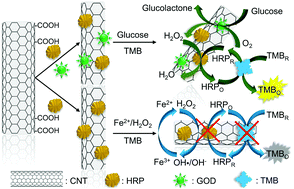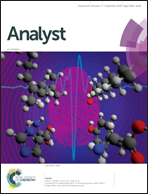Preparation of enzyme-functionalized carbon nanotubes and their application in glucose and Fe2+ detection through “turn on” and “turn off” approaches†
Abstract
A versatile enzyme-functionalized carbon nanotube (CNT) platform was fabricated by covalently conjugating glucose oxidase (GOD) and/or horseradish peroxidase (HRP) on carboxyl-group-functionalized CNTs. The GOD and HRP co-conjugated CNTs were used for the detection of glucose through the chain reaction between glucose, GOD and HRP. The locally formed H2O2 originating from the oxidization of glucose by GOD is able to further oxidize the 3,3′,5,5′-tetramethylbenzidine (TMB) substrate, resulting in the production of colorimetric products. The reaction between H2O2 and Fe2+ can deplete the amount of H2O2 in solution, which in turn decreases the oxidization extent of TMB and decreases the absorbance of the solution in the presence of HRP-conjugated CNTs. The hybrid materials can increase the number of active sites, thus increasing the amount of immobilized enzyme molecules on the surface. Electron transmission between different species is also accelerated and the co-conjugated enzymes can decrease the diffusion of intermediate products, further increasing the local concentrations of reactants. By utilizing these hybrid materials, glucose and Fe2+ were successfully detected. The linear dynamic range of glucose and Fe2+ was 1–100 μM, and the limits of detection for glucose and Fe2+ were 0.3 and 0.22 μM, respectively. The selectivity of glucose and Fe2+ was also studied by adding different kinds of interferents (e.g., sugars, metallic ions and biomolecules), and satisfactory results were obtained. In particular, Fe2+ can be distinguished from Fe3+. Meanwhile, the performance of these biosensors was also validated in biological samples (human serum and human serum albumin) using standard addition methods, and good recoveries were obtained.



 Please wait while we load your content...
Please wait while we load your content...